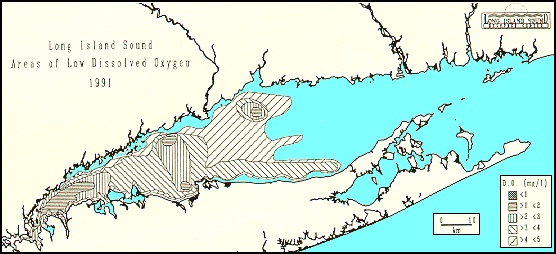 The map to the left shows areas of low dissolved oxygen (DO) concentrations in Long Island Sound. The map comes from the Environmental Protection Agency’s web site at http://www.epa.gov/NE/eco/lis/ccmp/hypox.html.
The map to the left shows areas of low dissolved oxygen (DO) concentrations in Long Island Sound. The map comes from the Environmental Protection Agency’s web site at http://www.epa.gov/NE/eco/lis/ccmp/hypox.html.
Marine bacteria use oxygen to degrade organic material. The oxygen used by the bacteria is replaced by mixing in water with higher oxygen concentrations. If there is a lot of organic matter available and the water exchange is low, a water mass or a sediment can become hypoxic (low oxygen concentrations) or anoxic (no oxygen). My group is especially interested in the effect of hypoxia/anoxia on sediments.
Several processes can cause high concentrations of organic material in sediments. The most common are inputs of particulate organic material from rivers and algal material. The amount of organic material from algae is controlled by the amount of inorganic nutrients available. If the concentrations of inorganic nutrients are high, there will be a lot of algae in the water column and a lot of algae-derived particulate organic matter can fall to the sediments. Areas that have high inputs of nutrients and therefore large amounts of algal-derived organic material are defined as euthrophic.
Recent studies suggest that the flux of dissolved organic matter (DOM) from sediment to overlying water can increase when the sediment surface becomes anoxic. DOM fluxing from the sediment to overlying water would amplify bottom-water hypoxia if the sediment-derived material is bacterially labile. We are carrying out a pilot study to determine fluxes of dissolved organic carbon, dissolved organic nitrogen, neutral aldoses, amino sugars, amino acids, and organic acids over the sediment-water interface under controlled oxic, hypoxic, and anoxic conditions.
In addition to scientific interest in the context of the global carbon cycle, this study has societal concern in the context of coastal eutrophication.
Related publications
- 2001, Skoog A., Lara R.J., Wedborg M., Kattner G. Spring-summer cycling of DOC, DON and inorganic N in a highly seasonal system encompassing the Northeast Water Polynya, 1993. Deep-Sea Research.48:2613-2629
- 2000, Burdige D.J., Skoog A., Gardner K. Dissolved and particulate carbohydrates in estuarine and continental margin sediments. Geochimica et Cosmochimica Acta. 64(6):1029-1041.1996, Skoog A., Hall P.O.J., Hulth S., Paxeus N., Rutgers van der Loeff M., Westerlund S. Early diagenetic mobilization and sediment – water exchange of dissolved humic substances in the coastal environment. Geochimica et Cosmochimica Acta 60(19):3619-3629.